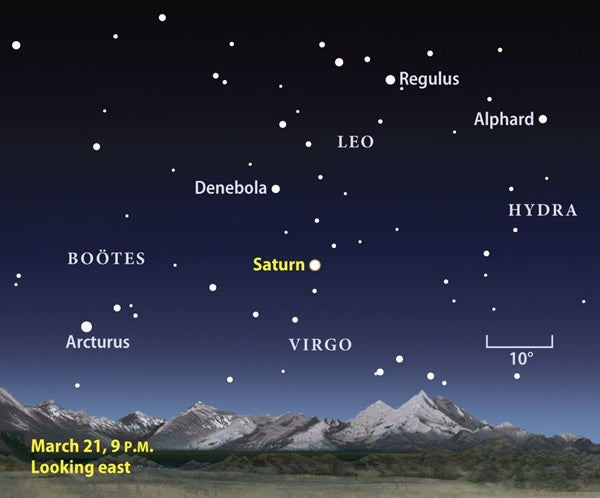Saturn reaches a point in its orbit called opposition March 21. At such times, the planet lies opposite the Sun from our perspective on Earth. This marks the best time of year to view the ringed planet because it lies closest to Earth and thus appears its biggest and brightest. At this opposition, Saturn will lie 790 million miles (1.27 billion kilometers) from Earth. Opposition is also when Saturn rises at sunset and sets at sunrise, so the planet remains visible all night.
Shortly after the Sun sets, look toward the east to see Saturn rising with the stars of Virgo the Maiden. The planet will form a low, wide triangle with two unusually named stars in Virgo. Saturn will lie roughly 4° east of Zavijava (Beta Virginis), and roughly 4° northwest of Zaniah (Eta Virginis).
Early evening is not the best time to turn your telescope on Saturn, however. That’s when the thickest part of our atmosphere will lie between you and the distant planet. Just 2 hours later, it lies one-third of the way up in a darker sky — a decent altitude for low-power viewing. For higher-magnification views (above 100x) or if you want to try photographing Saturn through your telescope, wait until the planet climbs at least halfway (45°) above the horizon, an altitude it achieves by 10 p.m. local time in mid-March.
Its disk reaches an apparent size of 20 arcseconds at opposition. Its diameter is small — 1 arcsecond equals only 1/3,600 of 1°. For comparison, a quarter seen at a distance of 860 feet (262 meters) covers 20 arcseconds. The planet’s rings more than double this value, spanning 44 arcseconds east to west. But they will be hard to see. At opposition, the rings tilt a scant 3° to our line of sight, and they show the same tilt at month’s end.
The narrow ring-tilt provides observers with telescopes a good view of the disk. Through a 4-inch scope, viewers will notice subtle shading, especially in the planet’s polar regions. The equatorial belts, now without the rings in the way, appear slightly darker than their surroundings.
Astronomy magazine Contributing Editor Mike Reynolds loves showing people Saturn. “Some people seeing it for the first time think it’s fake or a slide,” he says. “In reality, it’s one of the most amazing sights a telescope will reveal. And again this year, with the rings nearly edge-on, will be a real opportunity for amateur astronomers to educate the public about how the planets move.”
- Observing podcast: Double star Algieba, Saturn, and the Eight-Burst Nebula
- StarDome: Find Saturn in your night sky with our interactive star chart. Under “Options,” select “Show names,” select “Mark one specific object.” Scroll down the list of Planet/Object Selection, highlight “Saturn,” and click “OK.”
- Sign up for our free weekly e-mail newsletter to stay up to date on more great sky events.











